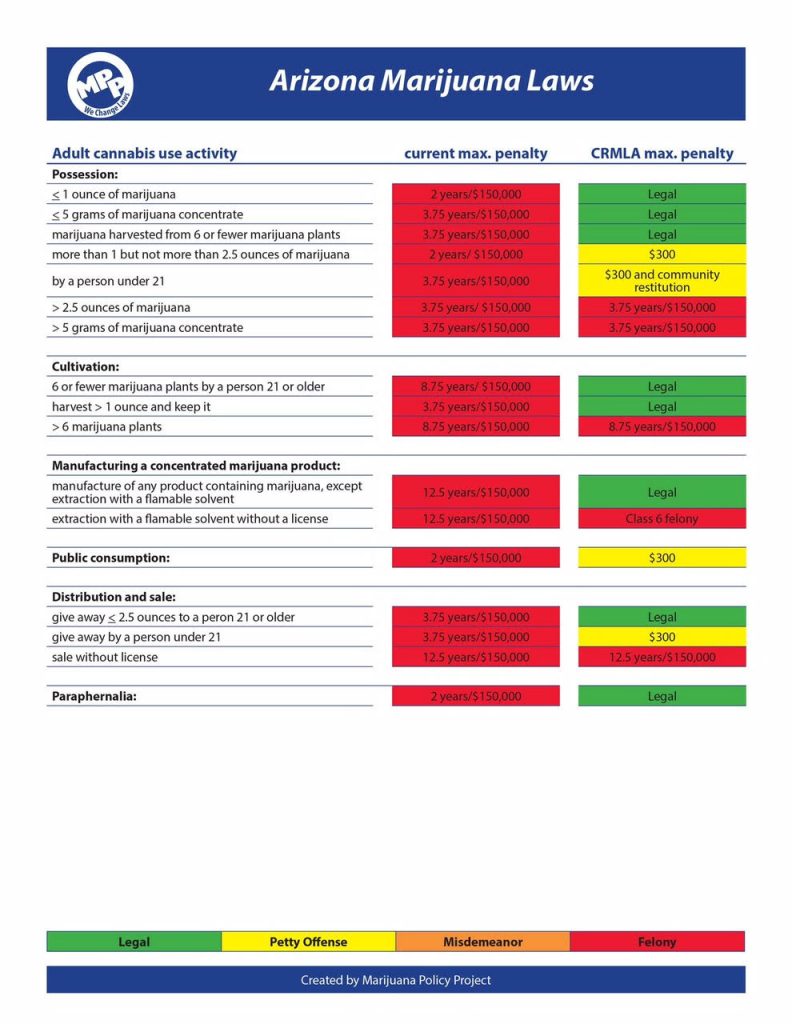There is no doubt that 2016 will be the biggest year in the short history of the marijuana law reform movement. Five states will have recreational cannabis legalization on the statewide ballot for their citizens to vote on in November. We here at The Marijuana Times are going to take a closer look at all 5, and we’re going to start with Proposition 205 in Arizona.
Prop 205 is similar to the legalization initiatives that will be appearing in other states. Here are some of the highlights of what Prop 205 would do if passed by the voters:
- It would legalize up to one ounce of marijuana possession for those aged 21 years or older and allow for private consumption. Currently this amount of possession comes with a maximum penalty of 2 years in prison and a $150,000 fine.
- It would legalize the growing of up to six marijuana plants by those aged 21 years or older in an enclosed, locked space within their residences and the possession of the marijuana produced by those plants in the location where it was grown. Property owners and landlords will still have the right to prohibit marijuana from being grown on their property. Currently growing less than 6 plants can get you almost 9 years in prison alone, not to mention the time you would get for possessing what you harvested.
- It would legalize the manufacture of concentrated marijuana products, something that currently comes with a maximum 12-and-a-half-year prison sentence.
- It would allow a limited number of licensed marijuana retail stores to sell marijuana to adults 21 years of age and older. The number of retail stores would be capped at 10 percent of the number of liquor store licenses, which is currently fewer than 180.
- It would allow localities to impose limits on where and when marijuana businesses are allowed to operate.
- It would require businesses to test marijuana products and adhere to strict packaging and labeling standards.
- It would enact a 15% excise tax on retail marijuana sales, which would be used to fund the implementation and enforcement of regulations. Any additional marijuana tax revenue would be allocated as follows: 40% to the Department of Education for school construction, maintenance, and operating costs; 40% to the Department of Education for full-day kindergarten programs; and 20% to the Department of Health Services for public education regarding the relative harms of alcohol, marijuana, and other substances.
What the measure does NOT do is legalize public consumption, it does not change existing penalties for growing more than 6 plants or possessing more than one ounce in public, it does not change the law in regards to driving under the influence of marijuana and it does not affect the current policies employers in the state have in regards to marijuana use.
Prop 205 also does NOT enact a tax on the sale of medical marijuana or affect the rights of medical marijuana patients that were established by Proposition 203.

A Long Road to Travel
It was not easy getting recreational marijuana legalization on the statewide ballot. “It took nearly one year to gather more than 258,000 signatures to ensure the initiative qualified for the November ballot,” Barrett Marson, a spokesperson for “Yes on 205” told The Marijuana Times. “It is a significant undertaking anytime you want to put an issue on the ballot. More than 150,000 valid signatures were needed and we easily cleared that hurdle.”
Some may remember how hard it was to pass medical marijuana legalization in Arizona; in 2010 Proposition 203 passed with only 50.13% of the vote. So Arizona is by no means a “lock” when it comes to legalization.
But so far, much of the feedback has been positive. “Voters are excited to get a say on the whether to end marijuana prohibition,” Barrett said. “We are running a vigorous campaign to educate voters about the benefits to ending prohibition.”
The Opposition
Prop 205’s opposition – “No on 205” – pushes the usual collection of “what about the children” mixed in with some “stoned drivers will be everywhere” with a sprinkle of “monopoly creation”. They valiantly attempt to paint legalization in Colorado as a catastrophe, something that is not borne out by any objective look at the facts on the ground.
“Crime, homelessness, and drug cartel activity have all increased in Colorado since legalization,” it says on the “No on 205” website, without any links or sources to back these claims. “State resources otherwise used for those in need are spent on the influx of homeless seeking shelter and services.”
As you can imagine, “No on 205” has made some missteps:
Barrett Marson told us that the opposition is doing its best to muddle the facts and what this vote is really about. “This isn’t a vote about whether to allow legal marijuana sales or ban marijuana,” he said. “Marijuana is here. The argument that if we keep it illegal use will go down is ridiculous. People purchase marijuana but on the black market. It is better to regulate and tax the sales then send money to drug cartels.”
Money for Schools
Pro-legalization forces have learned that the votes of parents are needed if these bills are going to pass. Parents are scared from the fear-mongering of the last several decades and are worried about how legalization will affect their children.
Besides showing parents that legalization does not mean kids are more likely to use marijuana, it’s also important to show that much of the tax revenue from legalization will go toward local schools. Prop 205 has this covered as mentioned above and as seen below:
The Race to the Finish
Time grows short before Election Day. By all accounts the vote in AZ is going to be close. A poll conducted last month showed 50% favoring Prop 205 with 40% opposed and 10% undecided.
“It will be a close campaign,” Barrett said of the days ahead. “Medical marijuana passed by about 4,000 votes in 2010. Since then, attitudes toward marijuana have evolved. The fastest growing age group of users are 55 and over. People understand the benefits of ending prohibition.”
The question, of course, is whether or not enough of them see the benefits of ending prohibition.
“We’re polling at 50% for, 40% against,” Daron Babin, the former State Director of Arizona NORML and the founder of Cannabis Radio, told The Marijuana Times. “So it just means this is going to be close.” Daron is gearing up for wall-to-wall Election Night coverage on Cannabis Radio, covering Arizona and all the other cannabis law reform measures across the country.
There are almost 7 million people in Arizona. Well over 5 million of them are aged 21 years or older. This means there could easily be some 500,000 regular cannabis users in the state. Think about what that means in terms of economic activity and think about what it means in terms of people being treated like criminals.
Here is a chance to change all of that and put Arizona on the path to wiping out marijuana prohibition for good.
Voters in Arizona will go to the polls to vote on Proposition 205 on Tuesday, November 8th.






